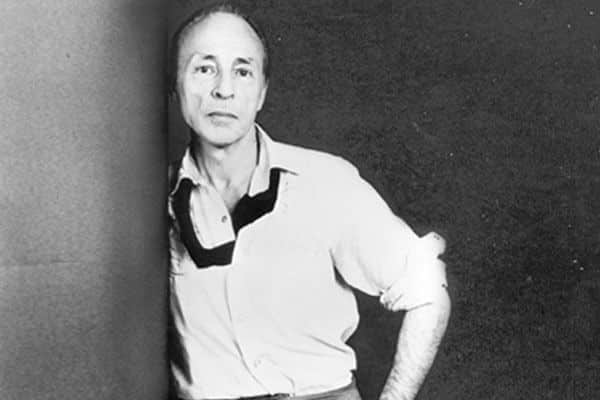
Born in St. Petersburg, Russia, George Balanchine (1904-1983) is regarded as the foremost contemporary choreographer in the world of ballet. He came to the United States in late 1933, at the age of 29, accepting the invitation of the young American arts patron Lincoln Kirstein (1907-96), whose great passions included the dream of creating a ballet company in America. At Balanchine’s behest, Kirstein was also prepared to support the formation of an American academy of ballet that would eventually rival the long-established schools of Europe.
This was the School of American Ballet, founded in 1934, the first product of the Balanchine-Kirstein collaboration. Several ballet companies directed by the two were created and dissolved in the years that followed, while Balanchine found other outlets for his choreography. Eventually, with a performance on October 11, 1948, the New York City Ballet was born. Balanchine served as its ballet master and principal choreographer from 1948 until his death in 1983.
Balanchine’s more than 400 dance works include Serenade (1934), Concerto Barocco(1941), Le Palais de Cristal, later renamed Symphony in C (1947), Orpheus (1948), The Nutcracker (1954), Agon (1957), Symphony in Three Movements (1972), Stravinsky Violin Concerto (1972), Vienna Waltzes (1977), Ballo della Regina (1978), and Mozartiana (1981). His final ballet, a new version of Stravinsky’s Variations for Orchestra, was created in 1982.
He also choreographed for films, operas, revues, and musicals. Among his best-known dances for the stage is Slaughter on Tenth Avenue, originally created for Broadway’s On Your Toes (1936). The musical was later made into a movie.
A major artistic figure of the twentieth century, Balanchine revolutionized the look of classical ballet. Taking classicism as his base, he heightened, quickened, expanded, streamlined, and even inverted the fundamentals of the 400-year-old language of academic dance. This had an inestimable influence on the growth of dance in America. Although at first his style seemed particularly suited to the energy and speed of American dancers, especially those he trained, his ballets are now performed by all the major classical ballet companies throughout the world.
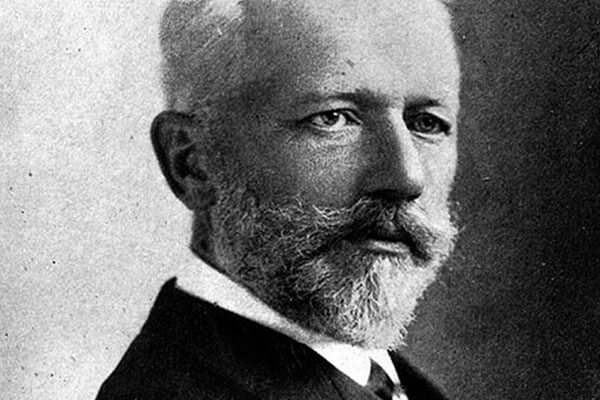
Peter Ilyich Tchaikovsky, born in Kamsko Votkinsk in the district of Viatka on May 7, 1840, was the son of a mining engineer. Although he began piano instruction at the age of five and showed signs of musical precociousness, a musical career was not anticipated at that time. In 1850, he was enrolled in the preparatory class of the School of Jurisprudence when his family moved to St. Petersburg. He was admitted to the School of Jurisprudence in 1852, and while he was still a student there, he composed a canzonetta that became his first published work. In 1859, he completed his course of study and took a post as a clerk in the Ministry of Justice, but he continued to pursue musical studies, including voice, thorough bass and composition. He resigned from his post in l863 and became a full-time student at the St. Petersburg Conservatory, directed by Anton Rubinstein. It was during this period that he made his debut as a conductor and composed The Storm, his only student composition to be heard with any frequency today. In it, he already exhibited stylistic elements prominent in his later works, including the influence of Russian folk-melody, a command of Western compositional techniques and a flair for brilliant orchestration. Even before his graduation in 1865, he was offered a position as teacher of harmony at what was to become the Moscow Conservatory.
In 1866, he moved to Moscow. There he came under the influence of Anton’s brother Nikolai Rubinstein and met Peter Jurgenson, who would eventually become his publisher. His First Symphony, begun in 1866, proved to be a difficult and laborious exercise for Tchaikovsky, who found the structural demands of the symphonic sonata form incompatible with his own style. It was not performed until 1869, but it was well received. His began first opera, Voyevoda, in 1867, the year in which he met Berlioz and Balakirev, leader of the nationalistic movement in Russian music. Balakirev conducted the first St. Petersburg performance of Tchaikovsky‚ symphonic fantasia Fatum, composed in 1868. Tchaikovsky later destroyed the work, as he would several others, but it was eventually reconstructed. Balakirev’s influence was also felt in Tchaikovsky‚Äôs first masterpiece, Romeo and Juliet, which he rewrote several times at Balakirev‚ suggestion. From 1870 to 1874, Tchaikovsky became increasingly interested in nationalistic music, although his conservatory training and familiarity with Western techniques kept him outside the circle of ‚ÄúThe Mighty Five‚Äù (Balakirev, Cui, Borodin, Mussorgsky and Rimsky-Korsakov). His nationalistic tendencies came to a peak with the opera Vakula the Smith, first staged in 1876, by which time his infatuation with nationalism in music had declined. He wrote his first music for solo instrument and orchestra from 1874 to 1877, including his celebrated First Piano Concerto (1875), and in 1875‚Äì76 composed his first ballet, Swan Lake. The first performance in 1877 was considered a failure, based less upon Tchaikovsky’s score (which was severely cut and further compromised with interpolations by other composers) than by a poor performance and mediocre physical production. Swan Lake was later revived with new choreography by Petipa and Ivanov in 1895, at which time it was recognized as a masterpiece of the ballet repertoire. Around the end of 1876, Tchaikovsky began to receive financial support from a wealthy widow, Nadezhda von Meck, who was to remain his devoted patroness for the next 14 years. With a new found financial security, Tchaikovsky embarked upon a period of incredible musical fecundity, producing such cornerstones of the international repertoire as his Fourth Symphony, the violin concerto and the opera Eugene Onegin. Most of his compositions from the years 1878‚Äì84 have not proved as enduring, although his stature in Russia continued to grow, as exemplified by two events in 1884: his opera Mazeppa was given concurrent productions in St. Petersburg and Mosocw and he was awarded the Order of St. Vladimir by the Tsar. In 1887, Tchaikovsky undertook his first foreign tour as a conductor, during which he met such notables as Brahms and Grieg. It was almost immediately after composing his Fifth Symphony in 1888 that he began work on his second ballet, The Sleeping Beauty. The work was given an elaborate premiere and was well received, but the public reaction did not meet the expectations of the composer, choreographer (Petipa) and designer-impresario (Vsevolozhsky), and it was to be some years before the work was recognized as one of the pinnacles of classical ballet. Tchaikovsky went on without pause to compose the opera The Queen of Spades, which received a successful premiere in 1890 and, along with Eugene Onegin, became an international repertory item. Its success brought about a commission from the Imperial Theatre for two one-act works, the opera Iolanta and the ballet The Nutcracker, one of his most enduringly popular works despite its disappointing reception at its 1892 premiere. Tchaikovsky‚Äôs Sixth Symphony, his most profoundly pessimistic work, was first performed October 28, 1893. Nine days later, he died. His death is universally considered to have been a suicide, but the circumstances leading to it have become a musicological controversy that is yet to be resolved. Once considered by his contemporaries to be too Western in his style, Tchaikovsky was later lionized by Igor Stravinsky as the most Russian of Russian composers. His greatest strength, his incomparable gift for melody, was also responsible for his difficulty in composing within the structures of the German school of composition, and his blatant emotionalism has alienated some commentators. Nonetheless, he is today one of the most popular of all composers, and he created masterpieces in every genre. His music seems uniquely suited to ballet, with its inexhaustible stream of melody, an instinctive sense of movement considered ideal for the human body, and an irresistible rhythmic pulse and brilliant orchestration. It is no coincidence that all three of his ballets are firmly entrenched in the international repertoire.
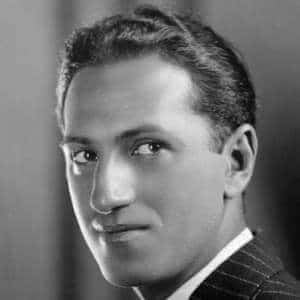
George Gershwin was born in New York City on September 26, 1898, as “Jacob Gershvin” – a child of a Russian immigrant whose original name was Gershovitz but adapted to the Americanized “Gershwin”.
He grew up in New York City and his precocious talent for music started early on a piano bought for his older brother Ira. After attending New York City public schools, he dropped out of high school to become a musician. At the age of 16 he worked as a song plugger for a Tin Pan Alley publisher and soon after he was hired as the rehearsal pianist for a new musical Miss 1917 by Jerome Kern and Victor Herbert. By 1919, he had a huge hit song of his own, “Swanee” with a lyric by Irving Caesar. Al Jolson sang it in a show called Sinbad and the song took off, selling more than a million copies of sheet music and more than two million phonograph recordings. And from there on, he moved from success to success, producing a catalog of over a thousand songs, most of which have achieved status as standards in American Popular song.
In the early years of his career, Gershwin’s songs had been inserted into other people’s shows, but in 1919 he wrote his first complete Broadway score, La, La Lucille with lyrics by Buddy De Sylva. His Broadway musicals to follow, majority written with brother Ira, included Lady, Be Good! (1924, including “Fascinating Rhythm”), Tip Toes (1925, including “Sweet and Low Down”), Oh Kay! (1926, including “Clap Yo’ Hands”, “Do-Do-Do”, “Maybe”, and “Someone To Watch Over Me”), Funny Face (1927, including “’S Wonderful”), Rosalie (1928, including “How Long Has This Been Going On”), Show Girl (1929, including “Liza”), Strike Up the Band (1930, including “I’ve Got A Crush On You” and “Soon”), Girl Crazy (1930, including “But Not For Me”, “Embraceable You”, “Bidin’ My Time”, and “I Got Rhythm”; the pit band for this show included an assortment of such future famous names as Gene Krupa, Glenn Miller, and Benny Goodman), Delicious (1931, including ” Blah Blah Blah”), Qf Thee I Sing (1931, the first musical to win the Pulitzer Prize and which included “Of Thee I Sing”, “Love Is Sweeping The Country”, and “Who Cares”),.Pardon My English (1933 including “Isn’t It A Pity” and “Lorelei”), and Let ‘Em Eat Cake (1933, including “Blue Blue Blue” and “Mine”).
Among the movies for which he and his brother wrote scores was Shall We Dance (1937), which included such classic songs as “They All Laughed”, “Let’s Call the Whole Thing Off”, and “They Can’t Take That Away From Me”. For A Damsel In Distress (1937) they wrote “Things Are I -‘ooking Up”, “A Foggy Day”, “Nice Work If You Can Get It”, and “I Can’t Be Bothered Now”.
At the time of his death, he was working on The Goldwyn Follies (1938) for which he and Ira wrote “Love Walked In” and “Love Is Here to Stay”. Other notable songs include “Somebody Loves Me” (lyric by Buddy DeSylva and Ballard MacDonald, from George White’s 5candals of 1924) and “The Man I Love” (lyric by Ira Gershwin, dropped from Lady Be Good! in 1924).
George Gershwin had serious ambitions in the realm of classical music, studying with such classical composers as Henry Cowell and Wallingford Riegger. His first public step in this direction came when Paul Whiteman commissioned a piece from him for a special concert at New York’s Aeolian Hall and the result was “Rhapsody in Blue” (1924). This triumphant score was followed by “Piano Concerto in F” (1925) and “An American in Paris” (1928). His score for Porgy and Bess (1935, with lyrics by Ira Gershwin and Dubose Heyward) straddles the world of opera and Broadway and includes such classic songs as “Summertime”, “Bess You Is My Woman Now”, “It Ain’t Neccessarily So”, and “I Got Plenty O’ Nuthin”‘. It was not originallv a success, but with the passage of years many have come to consider it the greatest American opera written to date.
Gershwin was an intensely social person, and his crowd included such personalities as Moss Hart, Lillian Hellman, Edward G. Robinson, film director Rouben Mamoulian, pianist and celebrity Oscar Levant, Harold Arlen, Vincente Minnelli, Irving Berlin, Dorothy Fields and Ginger Rodgers. He also served as a mentor to many younger musicians, including Morton Gould and Burton Lane.
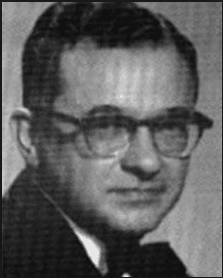
Hershy Kay, the American composer, orchestrator and arranger, was born in Philadelphia in 1919. He studied at the Curtis Institute of Music from 1936-1940, where his classes included composition taught by Randall Thompson. Self-taught as an orchestrator, he went to New York and had a successful career orchestrating Broadway musicals and ballets.
In 1954, George Balanchine commissioned Kay to compose the score for his ballet Western Symphony, a toe-tapping take on the American West. He later also wrote the score for Balanchine’s Stars and Stripes, based on Sousa’s music. Kay created ballet scores for several companies: New York City Ballet; Joffrey Ballet; Royal Ballet and Royal Danish Ballet. Kay’s reconstruction of Gottschalk’s Grande Tarantelle for piano and orchestra, later choreographed by Balanchine as Tarantella, led to a renewed interest in Gottschalk’s music.
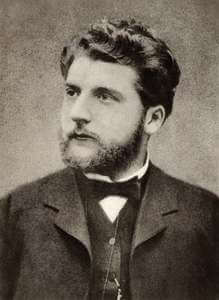
Georges Bizet was was registered with the legal name Alexandre-César-Léopold Bizet, but was baptized Georges Bizet and was always known by the latter name. He entered the Paris Conservatory of Music a fortnight before his tenth birthday.
Georges Bizet’s first symphony, the Symphony in C Major, was written there when he was seventeen, evidently as a student assignment. It seems that Bizet completely forgot about it himself, and it was not discovered again until 1935, in the archives of the Conservatory library. Upon its first performance, it was immediately hailed as a junior masterwork and a welcome addition to the early Romantic period repertoire. A delightful work (and a prodigious one, from a seventeen-year-old boy), the symphony is noteworthy for bearing an amazing stylistic resemblance to the music of Franz Schubert, whose work was virtually unknown in Paris at that time (with the possible exception of a few of his songs). A second symphony, Roma was not completed.
In 1857 a setting of the one-act operetta Le docteur Miracle won him a share in a prize offered by Jacques Offenbach. Georges Bizet also won the Music Composition scholarship of the Prix de Rome, the conditions of which required him to study in Rome for three years. There, his talent developed as he wrote such works as the opera Don Procopio. Apart from this period in Rome, Bizet lived in the Paris area all his life. His mother died shortly after his return to Paris. He composed the opera Les pêcheurs de perles (The Pearl Fishers) for the Theatre-Lyrique in 1863, which was an initial failure. He followed it with La jolie fille de Perth (1867), and Jeux d’enfants (Children’s games) for the piano.
The popular L’arlésienne were originally produced as incidental music for a play by Alphonse Daudet, first performed in 1872. Georges Bizet also composed a romantic opera, Djamileh, which is often seen as a precursor to Carmen, 1875. This latter opera is Bizet’s best-known work and is based on a novella of the same title written in 1846 by Prosper Mérimée. Bizet composed the title role for a mezzo-soprano. Carmen was not initially well-received but praise for it eventually came from well-known contemporaries including Claude Debussy, Camille Saint-Saëns and Pyotr Tchaikovsky. Their views proved to be prophetic, as Carmen has since become one of the most popular works in the entire operatic repertoire. However Bizet did not live to see its success, as he died from angina at the age of 36 a few months after its first few performances, on his third wedding anniversary. He was buried in the Père Lachaise Cemetery in Paris.
Georges Bizet’s music has been used in the 20th century as the basis for several important ballets. The Soviet-era Carmen Suite (1967), set to music drawn from Carmen arranged by Rodion Shchedrin, gave the Bolshoi ballerina Maya Plisetskaya one of her signature roles; it was choreographed by Alberto Alonso. In the West the L’Arlesienne of Roland Petit is well-regarded, and the Symphony in C by George Balanchine is considered to be one of the great ballets of the 20th century. It was first presented as Le Palais de Crystal by the Paris Opera Ballet in 1947, and has been in the repertory there ever since. The ballet has no story; it simply fits the music: each movement of the symphony has its own ballerina, cavalier, and Corps de Ballet, all of whom dance together in the finale.